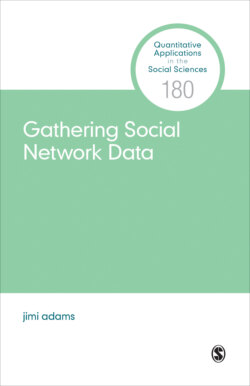Читать книгу Gathering Social Network Data - jimi adams - Страница 8
На сайте Литреса книга снята с продажи.
ОглавлениеPreface
Methods books generally take on one of two flavors. One option is basically a book of recipes. “You want to identify the effect of parental education on children’s mortality? Here’s the model and measures you need, how to gather them, what pitfalls to avoid, etc.” Another approach is basically to illustrate a set of examples of how people have done something in the past, then use those examples to derive a set of principles that scholars ought to follow. If the first is a recipe book, the second is a book on the principles of cooking. “Here’s how I selected which observations to record vs. which to ignore, how soon after fieldwork I made sure to translate my observations into fieldnotes, and the details of how I coded up those observations, including the version of the software I used.” From these practices, authors teaching ethnographic methods would extract general recommendations of best practices for standards of evidence, strategies for recording observations, schema for coding data, and what color pens you need to use to record those observations. OK, maybe they won’t get hung up on pen color, but you get the idea.
Here, I’m going to take the approach of focusing on the principles (rather than recipes) necessary for gathering social network data. That is, I’m rarely going to provide a single set of recommended practices that apply in all scenarios. Instead, I’m going to draw on examples of what people have done in previous studies to illustrate the various trade-offs that stem from different approaches to addressing the key sets of principles introduced across the chapters here. Given both (1) the variety of theoretical perspectives represented in the field and (2) that social networks is still a relatively young field in some aspects of its development, it should come as no surprise that there will be a variety of approaches—even for how best to address the same principles—represented within network scholarship.
Hopefully, this book will provide the tools allowing you to assess why that variety is appropriate (and occasionally when it is not) and then to draw on those principles and their applications in the examples used to help you design your own social network data collection efforts.
A Brief Note on Reading This Book
Given this variety, there remain quite a few unsettled debates on how social networks research is practiced. In the text, I focus on the primary principles that must be considered in any social network data collection project. Additionally, I also present many of the most common approaches to the resolution of these in practice. Further, I rely on a relatively liberal use of footnotes, often to provide pointers to alternatives to those common approaches. If you’re new to the field, it may be best to read without the footnotes to avoid getting into the details of what may at this point seem like internecine debates in the particulars of methodological approaches. However, if you’re looking to take a deeper dive into some of the (conflicting perspectives and historical roots of) material presented or make particular decisions in the design of your study, the footnotes frame many of these debates and provide pointers to other resources intended to facilitate that further exploration.
I also want to mention here at the outset one key aspect that I will not really address in this book. This is a book on the methods of data collection, not on social network analysis (Knoke & Yang, 2007). There are literally dozens of good books available on social network analysis (SNA), and I don’t feel the need to compete with them or to replicate their work. If analytic approaches to network data are what you’re after, I’d point you to one of those books (for a few excellent examples, see Appendix A).1 The aims of this book are complementary to these others. In fact, I make a few assumptions in this book that you are familiar with many basic terms in social network analysis, to avoid unnecessarily breaking up this text with those definitions. However, for those of you who are new to the field or just want to be sure we’re working from the same assumptions,2 I provide a glossary in Appendix A that provides definitions for many key terms (appearing in bold where they first occur in the main text).
1 Currently, most treatments of gathering network data are single chapters in larger books, which in turn correspond with the single units in large SNA courses. Most people come to realize the need for gathering social network data after having some sense of the theoretical or analytic aims they have for that data. As such, I expect for most readers that this book will not be your introduction to the field of social networks, but you will come to it with some familiarity with SNA’s basics.
2 After all, this is a highly interdisciplinary field, and depending on which tradition you’re coming from, these various perspectives occasionally have multiple words that mean the same thing or use the same word to indicate different ideas.
